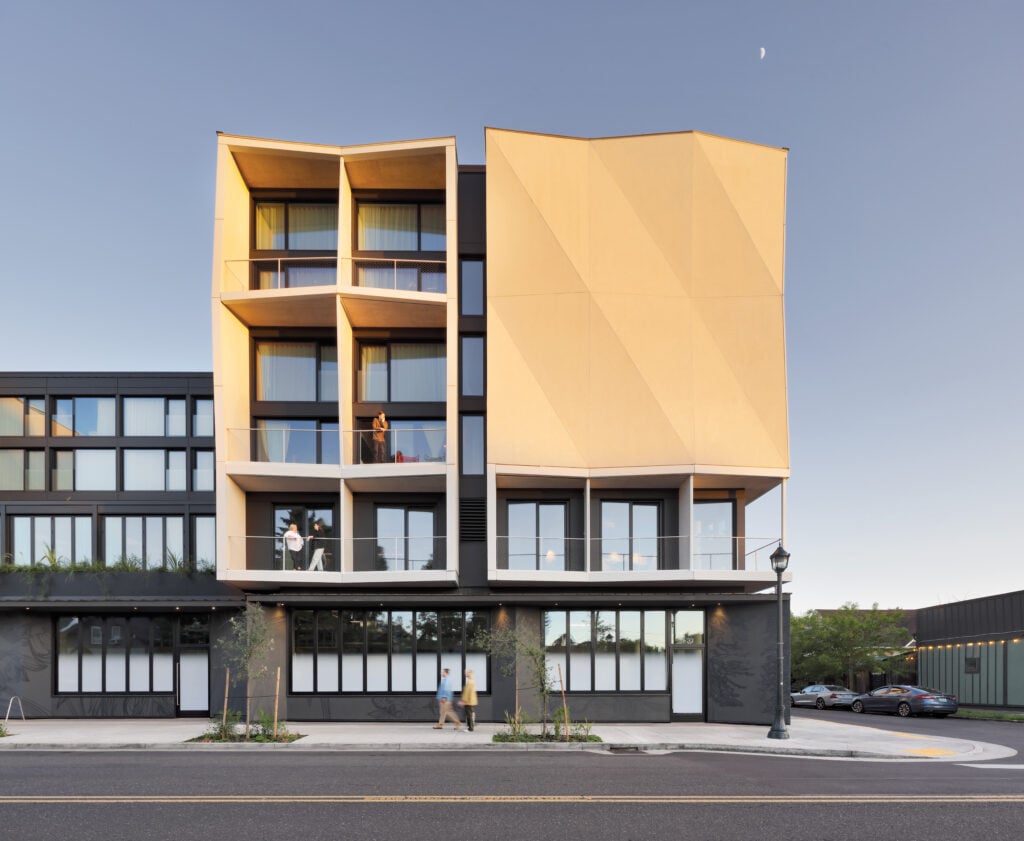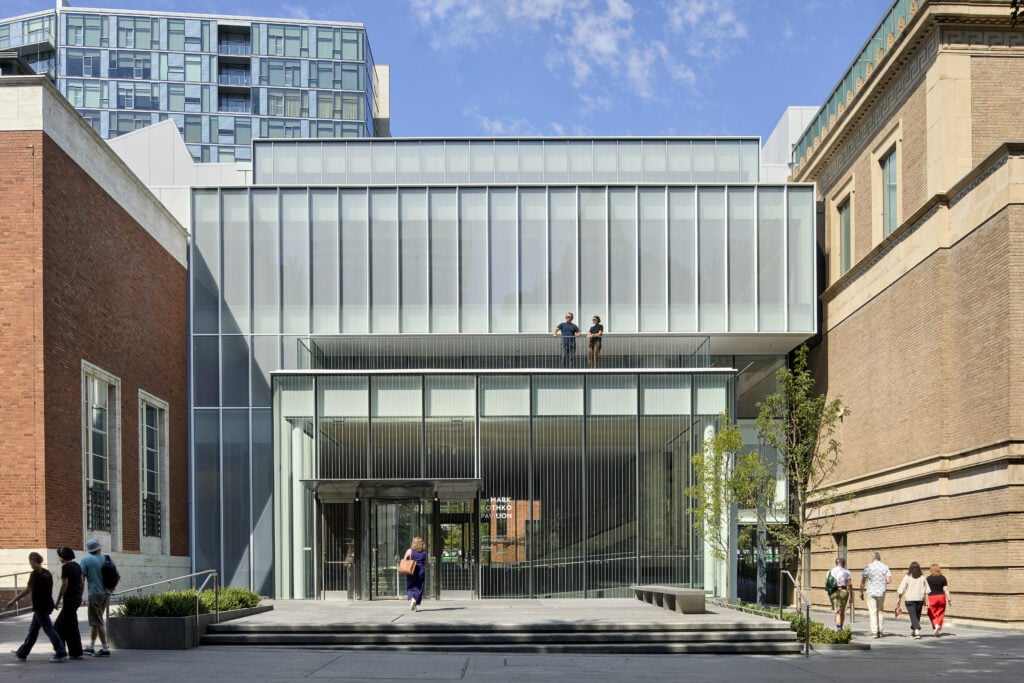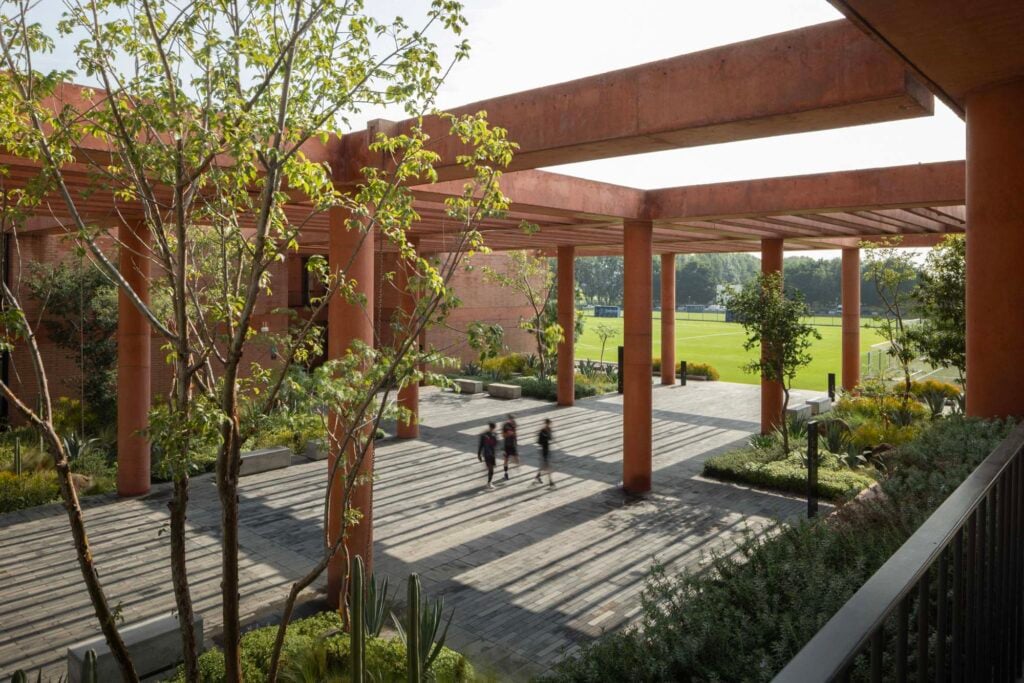
February 25, 2022
A Medical-Center Expansion by NBBJ Embraces its Northwest Setting
It’s early afternoon on a December day in the main lobby of the St. Michael Medical Center in Silverdale, Washington. Nurses eat lunch, patients’ relatives comfort one another, and a musician softly strums an acoustic guitar. Functioning like a great room, and inviting enough to encourage lingering—a rare trait in a hospital—the space features stadium-style seating that faces floor-to-ceiling curved glass windows. The apertures frame a view of a reflecting pond and boulder-strewn garden in the foreground, big-box stores sprinkled among the evergreens in the middle ground, and glimpses of the snowcapped Olympic Mountains beyond. Hovering above the lobby to the left, an oblong chapel is tucked behind a wall formed by vertical striations of warm wood, referencing the arboreal landscape outside. The soothing scene exudes serenity, exactly the therapeutic effect that Seattle-based architecture and design firm NBBJ intended when it conceived the ten-story, 612,000-square-foot expansion, which opened in December 2020.



Merging a new main hospital, a medical pavilion, and a parking structure on a site previously home to a single medical building, the combination acute care, cancer center, and clinical facility consolidates Virginia Mason Franciscan Health’s Kitsap County operations. Now one campus serves the needs of the vast Kitsap and Olympic Peninsulas, which lie west of Seattle, across Puget Sound. The topographically complex site shifts 80 feet in elevation from top to bottom, which led the architects to establish two different main entrances on either side of the building, accommodating traffic patterns that differ depending on a visitor’s direction of origin.
Given the commanding views to the west and southwest, hospital staff recommended adjusting the building’s direction, during early design charrettes, to capture not just the Olympic Mountains but also a year-round view of the saltwater Dyes Inlet. These connections to the natural setting are imbued throughout the complex, where a generous tree canopy on the northern and eastern edges shelters a section of the eight-mile Clear Creek Trail. The expansion’s Mountain View entrance, where the great-room lobby can be found, also allows passage into a healing garden, where running water pools around natural boulders—remnants of the glaciers that carved out Washington’s Puget Sound region.
“For patients and staff, this is a place of relief and purity,” says NBBJ’s lead architect Chuck Kolb.
Behind the garden the double-glazed, curved glass curtain wall facade, made of low-e glass and insulated metal panels, relies on an extensive array of static brise-soleils to reduce solar gain. “The sunshades pay for themselves,” Kolb explains, noting that there’s less need for mechanical ducts and systems thanks to a reduction in peak load. Large chillers—essentially commercial-grade heat pumps—handle most of the heating and cooling.


To the left of the curved main facade, concrete block cladding echoes the geological history of the site, as does the use of gabion walls in the rear parking garage. Enclosed in part by this cladding, the cancer center takes great pains to improve the tedious experience of receiving a transfusion, which can take up to six hours. NBBJ made sure every infusion station has views of the mountains, forest, or water while also configuring the space to enable patients to select privacy or communal seating during the six hours they’re being transfused.
“It gives you a choice,” says Ronn Goodnough, Virginia Mason Franciscan Health’s clinical lead for the expansion project. Goodnough was also once a patient at the hospital, going through two bouts of cancer, and he contributed his experience to the addition’s design process.
To improve patient and staff circulation, the third floor has been nicknamed the Autobahn for its seamless corridors and skybridges connecting all of the complex’s new volumes. That nod toward functionality across buildings is also a metaphor for the design’s success at uniting disparate elements of a growing health-care system to a singular setting.


Would you like to comment on this article? Send your thoughts to: [email protected]
Related
Projects
At This Portland Hotel, Wellness Is the Ultimate Sustainability
Designed by LEVER Architecture for developer-builder Solterra, the Cascada Hotel and Spa embraces low-carbon, health-centric luxury.
Projects
The New Portland Art Museum’s Rothko Pavilion Favors Connection
The glass-ensconced expansion acts as a transparent crossroads between the museum’s two historic buildings while preserving a pedestrian pathway.
Projects
Atlas Academy Rethinks the Stadium as a Miniature City
Mexico’s Atlas FC and Sordo Madaleno Arquitectos transform a flat site into a 90,000-square-foot campus, blending athletics and community in one adaptable structure.





